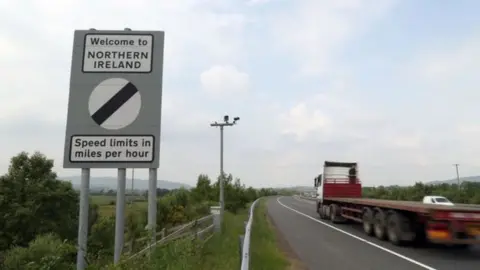Brexit: NI Committee believes a tech solution to border issue possible
 Getty Images
Getty ImagesA technical solution to the Irish border Brexit issue is possible, a majority of MPs on the Northern Ireland Affairs Committee have concluded.
They also believe that a system could be "designed, trialled and piloted" in under two years.
However, they note that such a system would be a "world-first" and requires a high degree of political trust.
Labour member John Grogan did not support the conclusions saying they are "based on a wing and a prayer".
The UK and EU have agreed there should be no hardening of the border as a result of Brexit but remain at odds on how to achieve that.
The UK government is seeking changes to the border "backstop" it had previously agreed with the EU.
The backstop is an insurance policy designed to prevent physical checks on the border between Northern Ireland and the Republic of Ireland.
It would mean the UK remaining in a customs union with the EU and Northern Ireland staying in the EU's single market for goods.
It would be used in the event that a trade deal or technical solutions cannot keep the border as frictionless as it is now.
The committee has decided that "on the balance of evidence" a technical solution can be achieved.
An earlier report from the committee in 2018 said it had not seen any technical solutions anywhere in the world that would remove the need for physical infrastructure at the border.
However, it says it has now been persuaded by further evidence that "bespoke arrangements" could work for Northern Ireland.
'Mobile inspection units'
It has listened to evidence from two customs consultants - Lars Karlson and Hans Maessen.
Mr Karlson, formerly a senior Swedish customs officer, wrote a report for the European Parliament in 2017 on how technology could be used at the border.
Mr Maessen, is a Dutch customs expert who has advised the pro-Brexit ERG group of MPs.
They suggested similar ideas such as using software, tracking technology and trusted traders schemes.
They also suggested that any physical checks of goods could be carried out at a company's premises or by "mobile inspection units".
Allow X content?
The report concludes that all the proposals would require the EU and UK to share "highly integrated digital systems" such as the EU's VAT information exchange system.
However, it is not clear on what terms the UK could have access to all the required EU systems.
For example, although Norway has a very close relationship with the EU, it has not been given full access to the EU VAT system.
The report also concludes that any technical solution would also require "special solutions for agricultural goods" but does not elaborate on what those solutions might be.
The dissenting member, John Grogan, said he continues to support the conclusions of the earlier report.
"In our report published just a year ago, we concluded that 'we have had no visibility of any technical solutions, anywhere in the world, beyond the aspirational, that would remove the need for physical infrastructure at the border," he said.
"I see no reason to change that judgement.
"In reality, the report is aimed largely at wavering Conservative MPs, unsure whether to back the prime minister in next week's vote."
